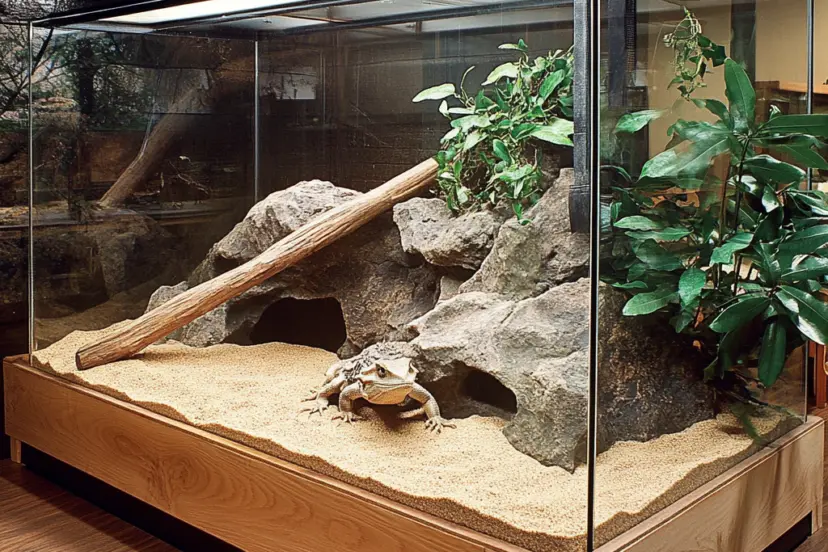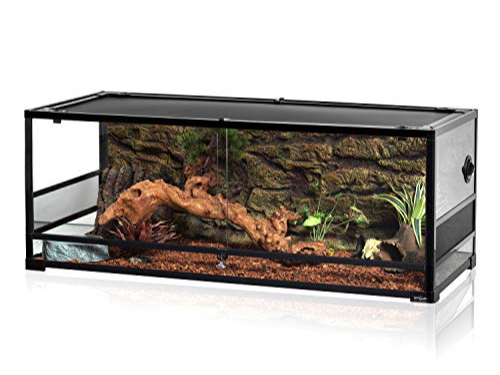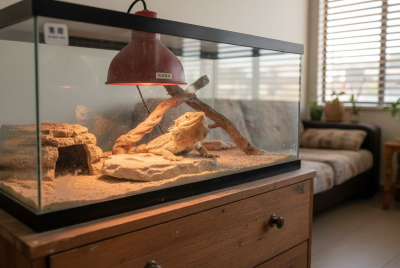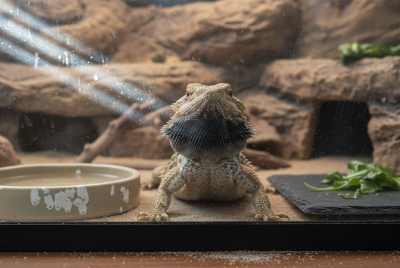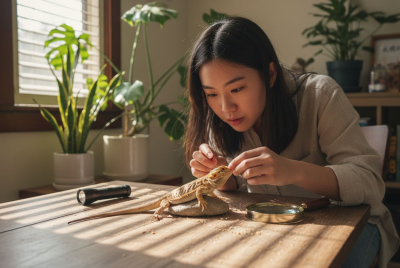Bearded Dragon Tank: The Ultimate Guide
As a bearded dragon owner, one of the most important decisions you’ll make is setting up the perfect tank for your scaly companion. A well-designed enclosure is essential for keeping your dragon healthy, comfortable, and active. In this guide, I’ll walk you through everything you need to know about choosing the right tank, setting it up properly, and maintaining it for your bearded dragon’s long-term well-being.
Why a Proper Tank is Essential
Your bearded dragon’s tank is more than just a place to live—it’s their entire world. A tank that doesn’t meet your dragon’s needs can lead to stress, health issues, and a shorter lifespan. The right tank will mimic the natural environment of the Australian outback, where these reptiles thrive. So, let’s talk about how to build the perfect habitat for your bearded friend.
Choosing the Right Size Tank
The size of your bearded dragon’s tank plays a huge role in their happiness and health. Many people make the mistake of choosing a tank that’s too small, especially as their dragon grows.
Recommended Tank Sizes Based on Age
For baby dragons (hatchlings to juveniles under 10 inches), a 20-gallon tank may suffice. However, these little guys grow fast! By the time your dragon hits 12 inches (usually around 6 months old), it’s time to upgrade. For adults, a 75-gallon tank is the absolute minimum, but ideally, you’ll want something larger—closer to 100 gallons. The bigger the tank, the better the experience for your dragon.
Why Bigger is Better for Adult Bearded Dragons
Bearded dragons are active creatures that love to explore, bask, and climb. A larger tank allows them to stretch out, move around, and engage in natural behaviors, which contributes to their overall mental and physical health. A cramped enclosure can lead to boredom, stress, and even obesity.
Best Types of Bearded Dragon Tanks
There are several types of enclosures to choose from, and each has its pros and cons. Let’s break down the most popular options.
Glass Tanks
Glass tanks are a popular choice for many bearded dragon owners because they’re readily available and offer great visibility. However, they can be heavy and don’t retain heat as well as other materials. If you go with glass, make sure the tank has a mesh top for proper ventilation.
Wooden Enclosures
Wooden enclosures, like melamine or plywood tanks, are fantastic for insulation, keeping your dragon’s habitat at the right temperature. They also provide more privacy, which some dragons prefer. The downside? They’re harder to clean and might not offer the same visibility as glass tanks.
PVC or Plastic Tanks
PVC and plastic tanks are lightweight, durable, and easy to clean. They hold heat well and offer good insulation, making them another great option for bearded dragons. They’re also relatively affordable compared to large wooden setups.
Setting Up the Perfect Tank Environment
Once you’ve picked your tank, it’s time to set up the right environment for your bearded dragon. Creating the right temperature, lighting, and humidity levels is crucial for their health.
Temperature Control
Bearded dragons are cold-blooded reptiles, which means they rely on external sources to regulate their body temperature. You’ll need to create a temperature gradient in the tank, with a basking area on one side and a cooler side on the other.
Basking Area and Cool Side
The basking spot should be kept at around 95-105°F during the day, while the cool side should be around 75-85°F. This allows your dragon to move between the two zones to regulate their body temperature, just as they would in the wild.
Lighting: UVB and Heat Lamps
UVB lighting is an absolute must for bearded dragons. It helps them metabolize calcium and prevents metabolic bone disease, a common issue in captive dragons. Make sure the UVB light covers at least two-thirds of the tank, and replace the bulb every 6-12 months as it loses effectiveness over time.
Importance of UVB Lighting
Without adequate UVB exposure, bearded dragons can suffer from severe health issues, including weakened bones and lethargy. Invest in a high-quality UVB bulb and make sure it’s positioned about 10-12 inches away from your dragon.
Humidity Levels: Keeping It Right
Bearded dragons thrive in low-humidity environments, just like the arid Australian desert they come from. The tank’s humidity level should stay between 30-40%. Too much humidity can lead to respiratory infections, so be sure to monitor this regularly using a hygrometer.
Substrate Options for Bearded Dragon Tanks
Another critical choice is the substrate (the material at the bottom of the tank). Not all substrates are safe, so you’ll need to pick wisely.
Safe Substrate Choices
Some of the best substrate options for bearded dragons include reptile carpet, tile, newspaper, or even paper towels. These materials are easy to clean and reduce the risk of impaction (a blockage in the digestive tract that can occur if your dragon accidentally ingests loose substrate).
Substrates to Avoid
Avoid using loose substrates like sand, wood chips, or crushed walnut shells. While these materials may look natural, they pose a significant risk of impaction, especially for younger dragons who may inadvertently swallow them.
Furnishing Your Bearded Dragon Tank
Now that the basics are covered, let’s move on to decorating the tank! Furnishings help keep your bearded dragon entertained and mentally stimulated.
Hides and Climbing Structures
Your bearded dragon needs a couple of hiding spots—one on the warm side of the tank and one on the cool side. These provide a sense of security. Also, be sure to include climbing branches or rocks where your dragon can bask and explore.
Plants and Decor: What’s Safe?
Adding fake plants or safe, real plants like aloe vera can make the tank more visually appealing without harming your dragon. Just avoid anything toxic, as your dragon might nibble on decor.
Cleaning and Maintenance of the Tank
Keeping the tank clean is essential for your dragon’s health. A dirty enclosure can lead to illness and discomfort.
Daily Maintenance Routine
You’ll need to spot clean the tank daily, removing any waste and uneaten food. This helps prevent bacteria from building up and keeps the enclosure smelling fresh.
Deep Cleaning: How Often and How to Do It
Once a month, do a full deep clean of the tank. Remove all decorations, clean them with a reptile-safe disinfectant, and replace the substrate if needed. This will ensure that your dragon’s environment stays clean and sanitary.
Common Mistakes to Avoid When Setting Up a Bearded Dragon Tank
Even experienced owners can make mistakes when setting up a bearded dragon tank. Here are a few common errors to avoid.
Using Inappropriate Substrate
As mentioned earlier, loose substrates like sand can cause serious health problems. Stick with safe options like tile or reptile carpet.
Poor Ventilation
Make sure your tank has proper ventilation, especially if you’re using a wooden or PVC enclosure. Stagnant air can lead to respiratory problems for your dragon.
Conclusion
Setting up the perfect bearded dragon tank takes some time and thought, but trust me, it’s worth it! By providing your dragon with a spacious, well-furnished, and properly lit environment, you’ll ensure they live a long, healthy, and happy life. From choosing the right size tank to maintaining the right temperature and humidity, every detail matters when it comes to your dragon’s well-being.
FAQs
- How big should my bearded dragon’s tank be?
For adult bearded dragons, a minimum of 75 gallons is recommended, though ideally, you’ll want a tank closer to 100 gallons or larger. The extra space allows them to move, climb, bask, and explore, contributing to their overall health and well-being. - What’s the best substrate for a bearded dragon tank?
Safe substrate options include reptile carpet, tile, newspaper, or paper towels. These options minimize the risk of impaction, which can occur if your dragon ingests loose substrate like sand or wood chips. - How often should I clean my bearded dragon’s tank?
You should spot clean daily by removing waste and leftover food. Perform a deep clean once a month, disinfecting all decorations, replacing the substrate, and ensuring the entire tank is sanitary. - · Do I need a UVB light for my bearded dragon?
Yes! A UVB light is essential for bearded dragons to metabolize calcium properly, which prevents metabolic bone disease. Make sure the UVB light covers most of the tank, and replace the bulb every 6-12 months. - · What temperature should a bearded dragon’s tank be?
Your bearded dragon’s basking area should be between 95-105°F, while the cool side should be around 75-85°F. Maintaining this temperature gradient allows your dragon to regulate its body temperature effectively.

